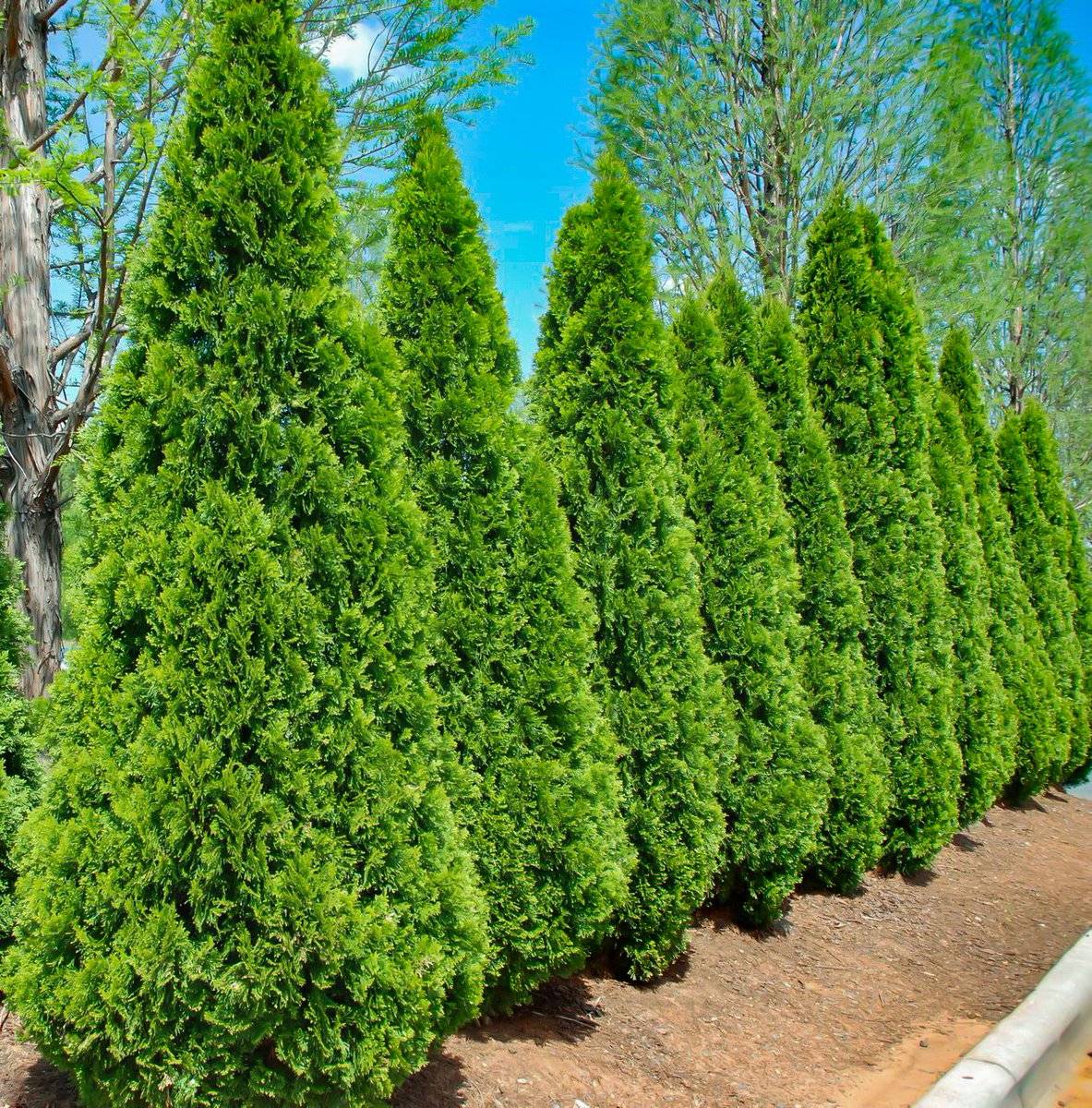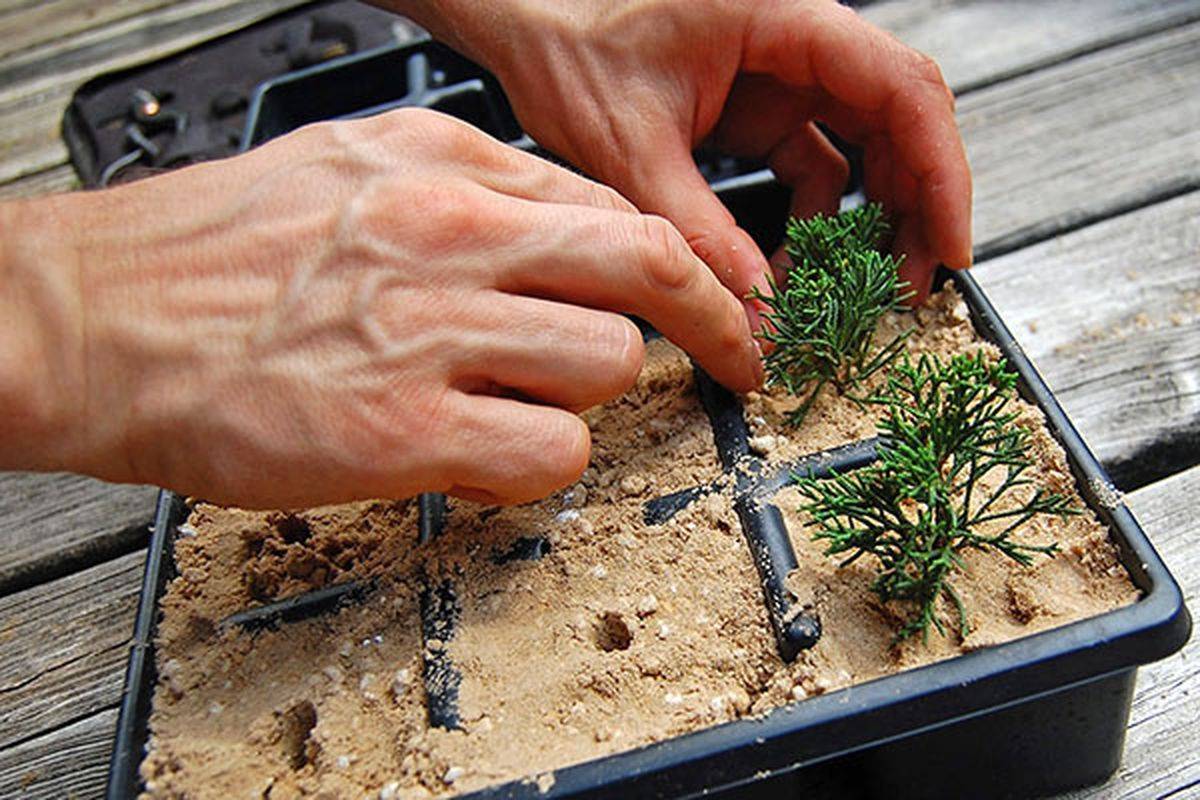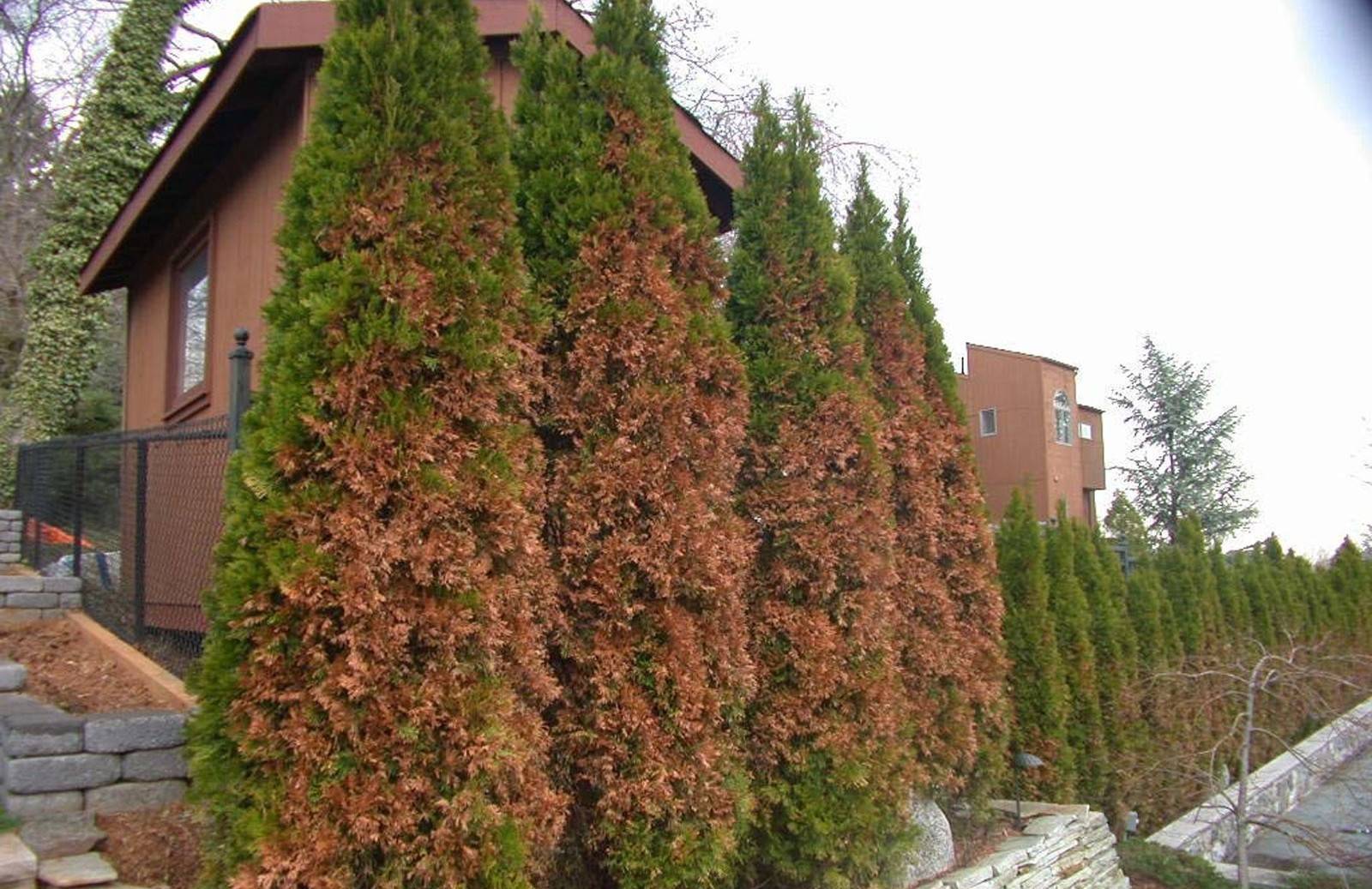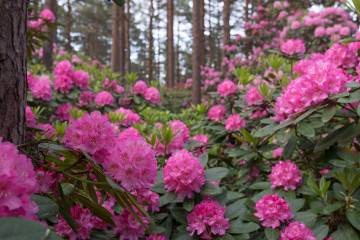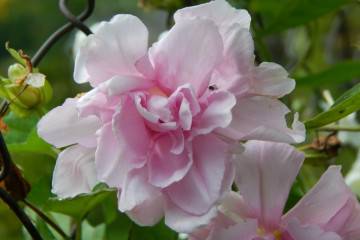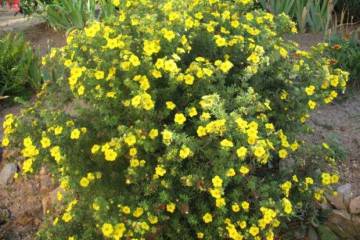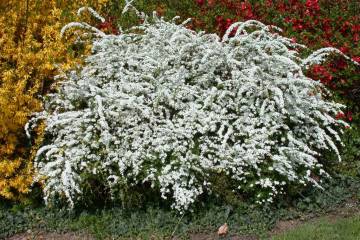Tuya Smaragd - description and size, fit and care
Content:
For landscape design, a plant such as western thuja is often used. The main advantages of growing are ease of maintenance and decorative appearance.
Thuja Smaragd western: description and dimensions
When choosing a thuja, it is worth stopping at the Smaragd variety.
Thuja Smaragd (second name is thuja Samarkand) is a coniferous evergreen plant. Although it can be called deciduous, the needles are very soft to the touch. Belongs to the Cypress family.
The crown is cone-shaped, but if desired, you can give it a different look.
During flowering, small brown buds form. Thuja secretes a phytoncide substance. It helps purify the air.
How quickly thuja Smaragd grows
This variety is characterized by a fairly rapid growth. On average, the tree grows 25 cm each year until it is fully grown.
In the first year, the tree adds about 1 m. Then every year it grows by 25 cm until it reaches 3-5 m. The tree grows for 7-10 years.
Planting and leaving
Tuya Smaragd needs regular care. It is also important to study all the nuances of planting so that a young seedling takes root without problems in a new place and quickly enters into active growth.
How to plant thuja Smaragd
Planting a seedling is not particularly difficult. Planting a coniferous plant is carried out in several stages. First of all, you need to choose a place where the thuja will grow. There is a difference in whether to plant a tree in the sun or in the shade. An open sunny area is not the best place. Due to the bright sunlight, the needles will turn yellow. But landing in the shade is contraindicated. It is best to plant a tree in partial shade. The first half of the day the tree will be in the sun, and the second half - in the shade.
Seedlings can be purchased at the nursery. If they have yellow or pale green needles, it is better not to buy such specimens. When choosing a plant, you need to pay attention to the root system. It should be well developed.
How to plant thuja Smaragd:
- Dig up the soil before planting. It is best to do this in a few weeks. After digging, rotted manure or compost is introduced into the soil.
- The optimal time of the year for planting thuja in the home garden is the second half of May - early June. It is not advisable to plant in autumn. If early frosts hit, the plant may die.
- Dig a hole and fill the drainage on the bottom, the layer should be about 15 cm. Expanded clay or crushed brick is suitable as drainage.
- The size of the hole depends on how much the root system has grown.
- Place the seedling in the hole and bury it with soil. During planting, the root collar should not be deeply deepened.
- Lightly compact the soil around the trunk.
At the end, water the seedling abundantly with warm water. Before watering, you can sprinkle the soil with wood ash.
Further care
After planting, it is necessary to properly care for the seedling so that it grows faster.
Watering mode
Thuja Smaragd belongs to moisture-loving plants, therefore, the soil near the tree should not be allowed to dry out.Watering should be moderate but constant. If it rains heavily for several days in a row, after they end, it is better to wait until the soil dries out, and only then resume watering.
Top dressing
Correct care is impossible without regular mineral and organic fertilizing. Decorative thuja needs feeding twice a season. In the spring, phosphorus-containing fertilizers (superphosphate, double phosphate), substances based on magnesium and potassium are introduced into the soil. The tree needs calcium (bone meal) as it grows.
If the needles become yellow, fertilizers are applied to the soil, which include iron. With brown spots on the needles, phosphorus is added to the soil.
Features of summer care
Taking care of a tree in summer is pretty easy. It is enough not to forget about watering and regularly apply top dressing to the soil. You also need to carry out sprinkling - watering the tree with a hose. Tuya loves it. During sprinkling, dust is washed off from the needles.
Preparing for winter
Before the onset of winter, thuja grown in the open field must be prepared for the cold weather. First of all, you need to stop making mineral fertilizing a few weeks before mid-October. Towards the end of October, the soil around the trunk is mulched. Then the tree is wrapped with agrofiber.
Reproduction
The only way to propagate a tree at home is by cuttings.
Propagation by cuttings
Cutting is an easy way to grow a plant at home. It is carried out in several successive stages.
Description of reproduction of thuja Smaragd by cuttings:
- In the upper part you need to find a strong skeletal branch, tear off 2-3-year-old growths with a sharp movement of the hand. It is best if the cuttings are with a small piece of bark. So they will quickly take root in a new place. A plant obtained from a lateral shoot can grow irregularly shaped. Cuttings should be 10-15 cm long.
- The cuttings are planted immediately. You cannot store them, they dry out quickly.
- Greens are cut from the bottom of the branches and the bark is peeled off.
- If the cutting is too lush, most of the greenery can be cut off.
- After the twigs are placed in a growth activator (epin) for 12 hours.
- Now you can start preparing the substrate. To do this, you need to mix river sand, peat and leafy soil.
- Moisten the soil and place the cuttings.
- Cover the containers with a bag to create a greenhouse effect.
- Place containers in a warm and bright place with diffused light. Moisten the substrate regularly.
After a while, roots will begin to appear on the cuttings. As soon as the root system gets stronger, the cuttings can be transplanted into open ground if the cuttings were carried out in the warm season. If grafting was carried out in the fall, it is better to wait until next year.
Why does thuja turn yellow
Often, when growing thuja, you have to face such a problem as yellowed needles. There can be many reasons, but most often the problem lies in improper care.
Why does thuja turn yellow:
- thuja was struck by fungal diseases, due to which the needles turn yellow, and the shoots acquire a brown tint. You can save the tree as follows: cut off all damaged shoots and burn them. Spray the plant itself with fungicides;
- the tree may begin to dry due to the thuja aphid. If you do not start fighting insects in time, they can destroy the tree.Spraying with karbofos will help get rid of the pest;
- thuja western often turns yellow due to the false shield. The first sign is that reddish growths, similar to cones, begin to appear on the needles. In the fight against the pest, drugs karbofos and rogor are effective.
If thuja needles turn yellow, what to do:
- first of all, it is worth analyzing watering. Whether there were violations in it, whether the soil was dry;
- examine the tree. The cause of the yellowing may lie in insects;
- apply mineral or organic fertilizers, if they have never been added or added before, but rarely.
A quick response to this problem will allow you to immediately cope with it and not bring to the death of the tree.
What are the thuja
Now there are a huge number of varieties with different characteristics and appearance. You can buy a thu mix, where there will be several different varieties at once.
Western
Thuja western (in Latin Thuja occidentalis) is an evergreen coniferous tree. Young specimens are distinguished by a pyramidal crown. As it grows, it becomes tapered.
Eastern
This variety grows in temperate climates with warm winters. In its natural environment, it grows on rocks. It reaches a height of up to 10 m.
Giant
Thuja giant, or folded, grows to a height of 70 m. Decorative varieties of this variety grow more miniature.
Japanese
This variety is distinguished by its demands on air purity, therefore it does not take root in urban conditions. In its natural environment, it grows in high mountain areas.
Korean
This variety belongs to shrubs. The plant looks like a creeping crop, the lower branches are almost on the ground. The underside of the crown is silvery, the top is green.
Popular varieties of western thuja
Western thuja varieties:
| Name | a brief description of |
| Thuja Brabant | This variety is fast growing. The average height is about 5 m. The growth is about 40 cm per year. |
| Aurea Nana (golden thuja) | The characteristic difference between this variety is the bright yellow needles. It will grow up to 1.5 m in height. |
| Blue Con (blue thuja) | An adult tree is characterized by a conical shape of needles. In favorable growing conditions, it can reach up to 2-3 m. |
| Danica | The variety was bred in 1948, but is still often used in landscape design. The shrub is spherical and up to 80 cm high. |
| Columna | It is characterized by a narrow crown, grows up to 3 m by 10 years. Used to create a hedge. |
| Teddy | The crown grows very slowly. A young tree has soft needles, becoming prickly as it grows. |
| Martin | The tree of this variety grows up to 1.5 m. The crown is strongly thickened cone-shaped. The buds are brown and long (about 10-12 cm). |
| Mickey | A dwarf variety, the crown differs in a conical shape. The needles are bright green. The plant normally survives short-term drought. |
| Sunkist | The average plant height is 2-4 m. In spring, the crown is lemon-colored, in summer it becomes golden, and in autumn it is bronze. To make the color of the needles more saturated, the seedlings need to be planted in the sun. |
| Hoseri | Crohn of an unusual spherical shape. The needles are bright green in color, in the fall it acquires a bronze color. Can be planted in the shade. |
| Fastigiata | A variety of German selection. The crown is conical, the height of an adult tree is 1.2 m. The needles are dark green in color. |
| Little Giant | The crown is oval, the shoots are very thickened. The needles are green-bronze in color. Grows up to 80 cm. |
Thuja is a very beautiful and unpretentious plant to care for, which is ideal for landscaping both city parks and private gardens. One of the popular varieties is thuja Smaragd, but you shouldn't dwell only on it.Among all the varieties, there are very unusual specimens that will decorate any garden.
